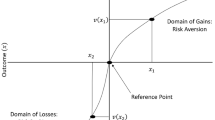Abstract
Although often used, Desor's figure-placement procedure makes an assumption that has not been tested. Two studies briefly reported indicate that the assumption that a constant criterion of crowdedness is being applied to different conditions is not always true. Several implications for simulation techniques and for general research strategies are discussed.
Similar content being viewed by others
References
Altman, I.The environment and social behavior. Monterey, Calif.: Brooks/Cole, 1975.
Baum, A., & Davis, G. E. Spatial and social aspects of crowding perception.Environment and Behavior, 1976,8, 527–544.
Baum, A., & Valins, S. Residential environments, group size, and crowding.Proceedings of the 81st Annual Convention, American Psychological Association, 1973, 211–212.
Baum, A., & Valins, S.Architecture and social behavior: Psychological studies of social density. Hillsdale, N.J.: Erlbaum, 1977.
Cohen, J. L., Sladen, B., & Bennett, B. The effects of situational variables on judgments of crowding.Sociometry, 1975,38, 273–281.
Cozby, P. C. Effects of density, activity, and personality on environmental preferences.Journal of Research in Personality, 1973,7, 45–60.
De Long, A. J. The use of scale models in spatial-behavioral research.Man-Environment Systems, 1976,6, 179–182.
De Long, A. J. The accuracy of spatial perception by informants in scalemodel environments.Man-Environment Systems, 1977,7, 55–58.
Desor, J. A. Toward a psychological theory of crowding.Journal of Personality and Social Psychology, 1972,21, 79–83.
McKechnie, G. E. Simulation techniques in environmental psychology. In D. Stokols (Ed.),Perspectives on environment and behavior: Theory, research, and applications. New York: Plenum Press, 1977.
Miller, S., & Nardini, K. M. Individual differences in the perception of crowding.Environmental Psychology and Nonverbal Behavior, 1977,2, 3–13.
Schafer, E. L., & Richards, T. A. A comparison of viewer reactions to outdoor scenes and photographs of those scenes. In D. Canter & T. Lee (Eds.),Psychology and the built environment. New York: Halstead, 1974.
Sundstrom, E. Crowding as a sequential process: Review of research on the effects of population density on humans. In A. Baum and Y. Epstein (Eds.),Human response to crowding. Hillsdale, N.J.: Erlbaum, 1978.
Winkel, G. H., & Sasanoff, R. An approach to an objective analysis of behavior in architectural space. In H. Proshansky, W. A. Ittelson, & L. G. Rivlin (Eds.),Environmental psychology: Man and his physical setting. New York: Holt, Rinehart and Winston, 1970.
Reference Notes
Firestone, I. J., Karuza, J., Greenberg, C. I., & Kingama, K. The perception of crowding: Modality, perspective and feedback effects.EDRA 8 Proceedings, 1977, in press.
Greenberg, C. I., & Chambers, D. Further tests on the validity of the model room simulator on crowding threshold judgments.EDRA 9 Proceedings, 1978, in press.
Author information
Authors and Affiliations
Additional information
Michael Stevens assisted in conducting the research.
Rights and permissions
About this article
Cite this article
Knowles, E.S. A critique of figure placement procedures in studies of crowding. J Nonverbal Behav 3, 62–64 (1978). https://doi.org/10.1007/BF01114533
Issue Date:
DOI: https://doi.org/10.1007/BF01114533




